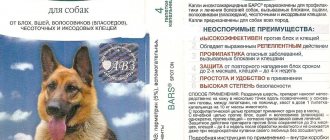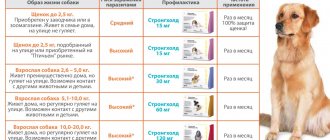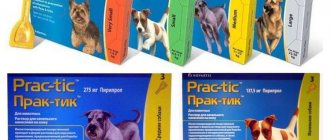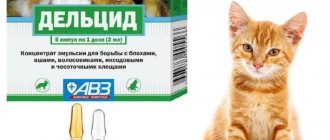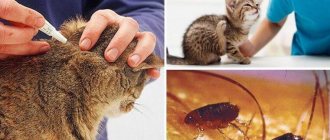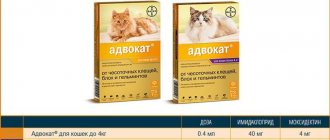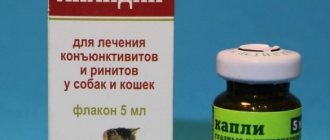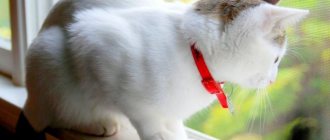Russian (AVZ) develops and produces medicines for domestic and farm animals. It produces insectoacaricidal products: sprays, shampoos, collars. An effective drug is “Bars” - drops against fleas and ticks for cats, the instructions for which must be studied before using the medicine. There is a product for treating kittens. It has a softer effect. "Leopard" kills not only adult ectoparasites, but also their larvae. The drug is also used to prevent infection.
Composition and pharmacological properties:
BARS® drops against fleas and ticks for cats contain fipronil - 10 mg/ml, diflubenzuron - 1 mg/ml and dicarboximide (MGK-264) - 1 mg/ml as active ingredients, as well as excipients.
The mechanism of action of fipronil, which is part of the drug, is to block GABA-dependent receptors of ectoparasites, disrupt the transmission of nerve impulses, which leads to paralysis and death of ectoparasites. Diflubenzuron, by inhibiting the synthesis of chitin in parasites, disrupts the process of molting, oviposition and hatching of larvae from eggs, which leads to a cessation of population replenishment. Dicarboximide is a synergist and is used with insecticides to increase their activity. Dicarboximide stops microsomal detoxification of the insecticide, increasing its toxicity to the parasite.
After skin application of the drug, the active substances included in its composition, without being absorbed into the systemic bloodstream, are evenly distributed over the surface of the body, accumulate in the sebaceous glands, long-term protecting the animal from ectoparasites.
Insectoacaricidal drops "Bars" in terms of the degree of impact on the body are classified as moderately hazardous substances; in recommended doses they do not have a resorptive-toxic, locally irritating or sensitizing effect; Causes irritation upon contact with eyes. The drug is well tolerated by dogs and cats of different breeds and ages, but is toxic to rabbits, as well as fish and other aquatic organisms.
How to use drops against ixodid ticks
Unlike other parasites, ixodid ticks are more likely to attach to dogs. However, cats are also at risk. The parasite gets onto the animal's fur and skin from grass or ground, sometimes from a tree or low bush.
Ixodid ticks are active from March to October. At this time, the ground is not covered with snow and has an acceptable temperature for the parasite. If the winter is warm, then this type of arachnid is active all year round.
To protect cats from ixodid ticks, insectoacaricidal treatment must be carried out every month. This applies to animals that go outside for walks. At home, infection with ixodid ticks is unlikely.
If prevention was not carried out on time, ticks can be found on the pet’s body. In this case, the use of Bars drops has its own peculiarities. It is necessary to carefully move the fur apart. A few drops of the medicine should be applied directly to the tick.
After half an hour, the parasite should die and fall off on its own. If this does not happen, you need to take special tweezers and unscrew the tick counterclockwise. It is important that the parasite comes out with the head. Otherwise, inflammation may occur.
After the tick has fallen off or been twisted out with tweezers, you need to contact a veterinarian. The cat could become infected with diseases carried by this parasitic arachnid species.
Doses and order of application.
Apply to animals once by drip application to dry, intact skin at several points in the back between the shoulder blades or in the neck at the base of the skull (in places inaccessible to licking by animals) in doses indicated in the table.
| Type and weight of the animal | Volume of the drug in the pipette, ml | Drug dose, ml per animal | Number of pipettes required for processing, pieces | |
| Cats | ||||
| up to 1 kg | 1,0 | 0.3 (10 drops) | 1 | |
| from 1 to 3 kg | 1,0 | 0.6 (20 drops) | 1 | |
| from 3 kg or more | 1,0 | 1,0 | 1 | |
The protective effect of the drug lasts for 1-2 months. Repeated treatments of animals are carried out according to indications, but not more than once a month.
When treating otodectosis, the auricles and ear canal are first cleaned of earwax, exudate and scabs, then 4-6 drops of the drug are instilled into each ear. To distribute the drug evenly, the auricle is folded lengthwise and its base is lightly massaged. The remainder of the drug in the pipette is applied to the animal’s skin between the shoulder blades. In advanced cases of otodectosis, complicated by otitis, antibacterial and anti-inflammatory drugs are prescribed and the auricular application of BARS® drops against fleas and ticks is repeated after 7-10 days.
The drug must be administered into both ears, even in cases of otodectosis affecting only one ear.
To prevent splashing of the drug (if the animal shakes its head), the animal's head should be fixed for several minutes.
In order to prevent re-infestation with fleas, the animals' bedding is replaced or the floors of the premises are treated with any insecticidal agent in accordance with the instructions for its use.
Flea Drops Application Guide
The medicine is distributed throughout the fat layer, which is located on top of the skin.
Therefore, the animal cannot be bathed 3 days before and 3 days after treatment. Otherwise, the fat layer may be washed away, the drops will have nothing to distribute or they will be washed away.
For cats, flea treatment is applied in the following order:
- The pipette is opened. To do this, its tip is broken or cut off with scissors.
- The fur on the withers is parted with your fingers to provide access to the skin. In this case, the animal’s head should be fixed.
- The required amount of the drug is applied to the withers. For cats of large breeds, medicine is also dripped between the shoulder blades.
- The area to which the drug was applied is well massaged. This helps the drops absorb faster and distribute evenly.
Before applying the medicine, you need to make sure that the fur is dry and clean, and that there are no wounds, scratches, etc. on the skin. Otherwise, the pet will be in pain and allergic reactions are possible.
If it snows or rains, then the animal should not be allowed outside for 5 hours from the moment of treatment. The drops will not yet have time to be completely absorbed, so they may wash off.
For 3 weeks after treatment, it is not recommended to bathe the cat using shampoo, soap, etc. Washing may weaken the protective effect of the insectoacaricidal agent.
Owner reviews
Elena: “I used to take expensive products: the dog is allergic, and the drops have to be chosen carefully. But it was to imported medicines that I became allergic. Then she spat and switched to Bars. There are no side effects, it repels ticks right away. A couple of times over the summer I found parasites on my body, but they didn’t dig in, they just crawled like plagues through my fur. I give it to the dog 3 times a season: the animal tolerates it well and doesn’t worry.”
Egor: “I always use Bars drops - they work great, I’ve never had a problem.” When we go to the forest to pick mushrooms, I additionally take a spray of the same brand: after returning home, about a hundred ticks crawl out of the dog, but none of them bite. This means the product works, but you can’t stop parasites from crawling on your fur.”
Nina: “The drops are not bad, but they worked better before. Dogs tolerate them normally, only the Chinese Crested itches on the sofa for about 5 minutes: it’s clear that the skin is irritated. Unfortunately, the product does not last as long as stated in the instructions - a maximum of 2 weeks, and only if you do not bathe often. I wouldn’t have noticed, but there are a lot of ticks in our area: I’ve picked them off my pets a couple of times. But it’s better with Bars than without.”
Precautions for humans
Be sure to read the instructions before using the drops. When processing, follow these simple precautions:
- carry out processing with rubber gloves;
- do not come into contact with food during the procedure;
- After all manipulations, wash your hands with soap;
- do not allow children to come into contact with the treated animal in the first two days;
- Dispose of used capsules correctly;
- If the product gets on your skin, rinse with warm water;
- If the substance is swallowed, consult a doctor immediately.
Treatment with drops for ear scabies
The drug is used to treat otodectosis. However, it should only be used with the permission of a veterinarian.
To rid a cat of ear mites, the product is applied to the skin in the withers area and directly into the ears. Even if one ear is affected, both should be instilled.
Before treatment with drops, the ears are cleaned of wax and waste products of microscopic mites, which look like black dirt. For this, special sprays are used, for example Auricap. Cleaning must be deep, so it is advisable to use cotton swabs or medical clips with cotton wool wrapped around them.
3-4 drops of Barca are instilled into clean ears. Then the ears must be thoroughly massaged. This will help the medicine distribute faster and prevent it from splashing across the surface of the coat.
Otodectosis can be complicated by inflammation. In this case, you will need antibiotics, immunomodulating agents, etc. Therefore, you should not treat the animal yourself. It's better to see a doctor.
Advice from experienced dog breeders
Dog owners who have been using Bars flea drops for dogs for a long time give only the most positive reviews about the drug.
In addition, they want to advise beginners to be sure to write down the processing date in a notepad. This is necessary in order not to miss the time of the next Bars treatment. Days when your pet's skin is left unprotected can become dangerous to its health.
Dog breeders also advise using not only drops, but also Bars collars during periods of particularly high parasite activity. Double protection will not hurt your pet.
Analogues of the drug
Although there are no complete analogues of Bars drops, there are many anti-tick drops with a similar composition and effect. The best ones:
| Analogue | Differences | average price |
| Inspector Total S | Also contains fipronil. Additionally, it eliminates roundworms and microfilariae larvae. Less likely to cause side effects. | 450 rub. |
| Advantix | Contains other active ingredients – imidacloprid, permethrin. Has a repellent effect against flies, mosquitoes and midges. | 460 rub. |
| Celandine | The action of fipronil is supplemented with permethrin. Does not work against demodectic mites. | 140 rub. |
| Frontline Spot On | Fipronil based drops. The concentration of the active substance is 2 times higher than that of Bars. In addition to fleas and ticks, it destroys mosquitoes. | 500 rub. |
| Dana Spot-On | Contains only fipronil (5%). The effect is worse. The drug is prohibited for kittens up to 12 weeks. | 130 rub. |
| Pract-tic | Medicine based on pyriprole (12.5%). Does not help against sarcoptic and otodectic mites. | 420 rub. |
| Rolf Club 3D | The effect of fipronil is enhanced by D-cyphenothrin and pyriproxyfen. Additionally, it has a repellent effect on blood-sucking insects. Eliminates parasites caught on the fur faster – in 2 minutes. Prohibited for puppies under 3 months. | 300 rub. |
| Mister Bruno | In addition to fipronil, it contains pyriproxyfen. Suitable for dogs older than 3 months. For younger puppies, there is a herbal preparation with oils of wormwood, neem, cloves and citronella. The drug is less common. | 220 rub. |
| BlochNet | In addition to fipronil, it contains benzyl benzoate and diethyltoluamide. Additional effect: repels mosquitoes. It has a pleasant scent, but the bottle is not convenient to use. Allowed from 10 weeks. | 115 rub. |
Review of 20 flea and tick medications for dogs
Contraindications
- Under no circumstances should drops be used if the cat is pregnant or nursing kittens.
- If the cat has recently suffered from an infectious disease and is currently just recovering, then you should not use Bars Forte, since the cat has not yet fully recovered its strength.
- Do not use drops on a kitten that has not yet reached ten weeks of age.
© shutterstock
It is important to know
In order for treatment and prevention of external parasite infestations to be truly effective and safe, it is important to take several factors into account.
Pet age
. Bars drops should not be used on puppies and kittens under 8 weeks of age. But treating young and adult animals whose weight does not reach 2 kg with such drugs is also contraindicated.
Health status
. Drops should not be used for the treatment and prevention of external parasites in dogs and cats with therapeutic or infectious diseases in the acute stage. The same applies to pets recovering from illness or surgery, animals with physical exhaustion and dogs/cats that are weakened due to very old age.
Pet's "status"
. Treatment should not be carried out on pregnant or lactating females. But it is possible and necessary to carry out such treatment before mating - this will protect both your pet and its offspring from infection by parasites and diseases that they carry.
Complications
Ear scabies can be treated quickly; advanced disease can lead to:
- to purulent otitis;
- hematoma of the auricle.
By scratching sore ears until they bleed, a dog or cat damages the delicate skin of the auricle. Pathogenic microorganisms can enter scratches and micro-wounds in the ear canal and quickly spread, causing purulent inflammation. Treatment will require antibiotics. In its advanced form, otitis media will become chronic and will appear periodically.
Hematoma (otherwise known as lymphatic extravasation) of the auricle is a complication of otodectosis, more typical for cats. It is diagnosed when, as a result of injury to the auricle (the cat scratches the ear with sharp claws), a blood or lymphatic vessel under the skin bursts. A hematoma forms in the area of the auricle. Surgical intervention is required - under anesthesia, the skin inside the auricle is opened and the contents of the hematoma are removed.
Combining Bars with other means
Please note that combining drops with other drugs is strictly prohibited. Such prohibitions were invented for a reason. The fact is that even drugs that differ in their principle of action can have identical compositions. As a result, in case of an overdose of the active substance, in this case fipronil, intoxication of the body is possible.
Alternatively, when drugs contain different substances in their composition, mixing of the main components is possible. Such reactions can cause weakening of the body, seizures or allergic reactions.
Side effects
If you follow the dosage and follow the developer's recommendations, there are usually no negative reactions. In case of individual intolerance to the components of the drug, complications arise in the form of excessive salivation, lacrimation, decreased appetite, and vomiting.
The same symptoms are observed when the dosage is exceeded or liquid gets inside; there may be muscle tremors. If such phenomena occur, you cannot continue treatment; wash the cat with shampoo. After this, contact your veterinarian to prescribe treatment. In case of contact with the mucous membranes of the eyes, rinse them with plenty of water.
Precautions for pets
Following safety precautions for humans alone is not enough. Please note that simple precautions should also be followed in relation to your pet:
- apply only a preparation suitable for the type and age of the animal;
- If your pet has an allergic reaction, immediately wash off the drops with water and visit a veterinarian;
- do not combine drops with other drugs.
With the right approach to processing, the procedure will take place without harmful consequences.
